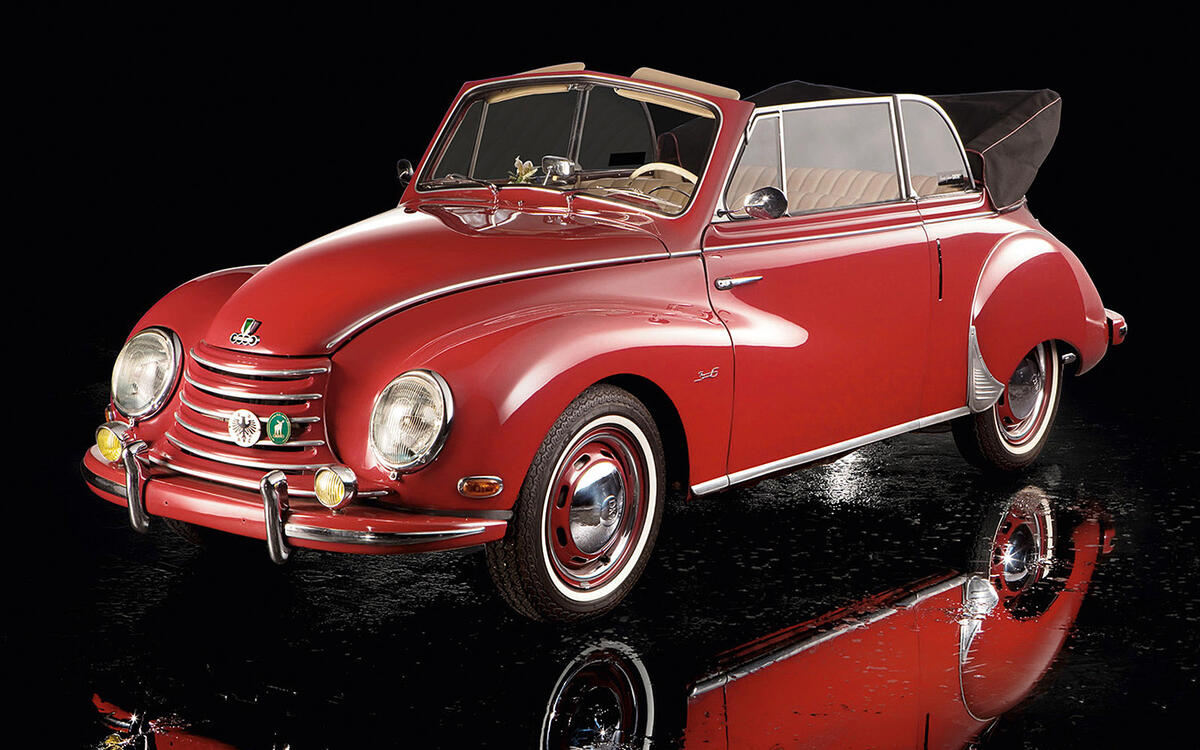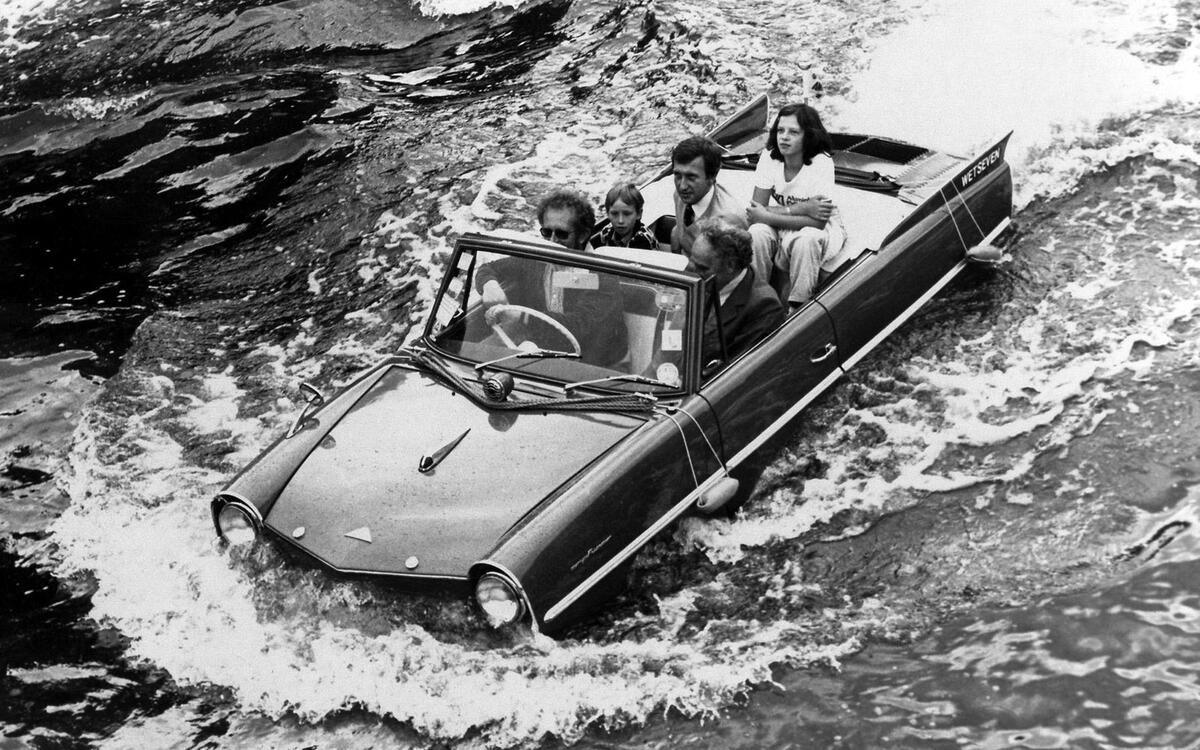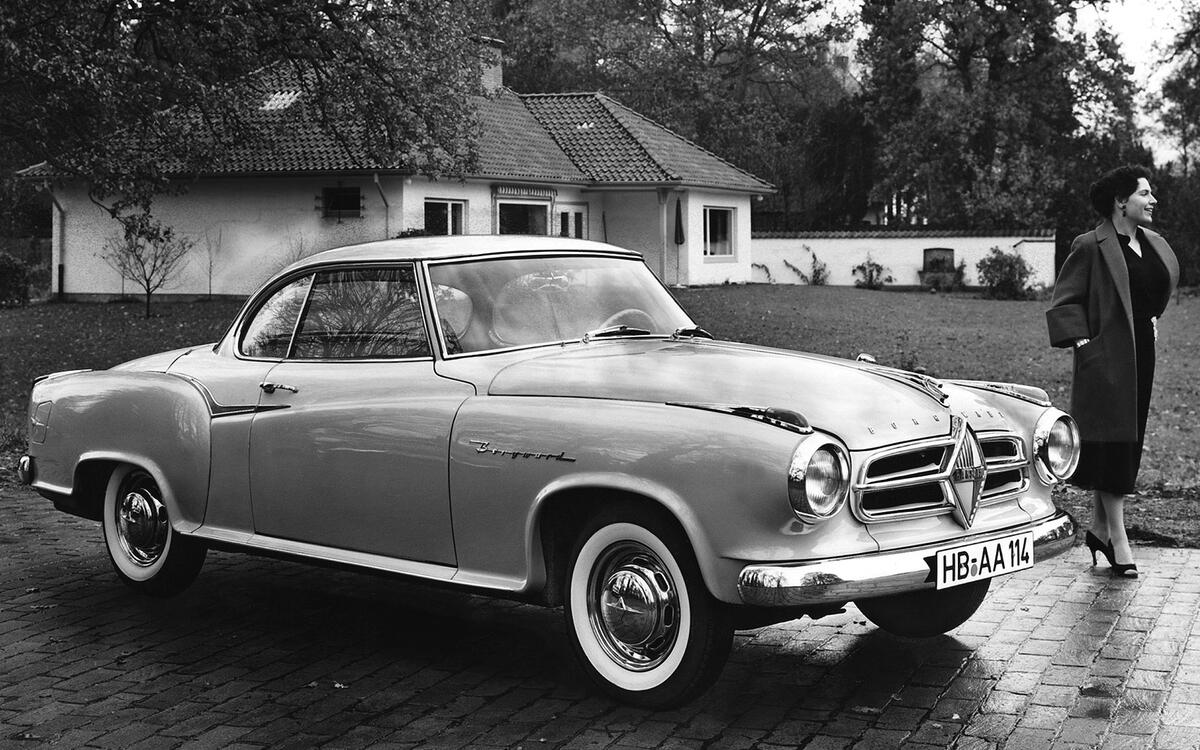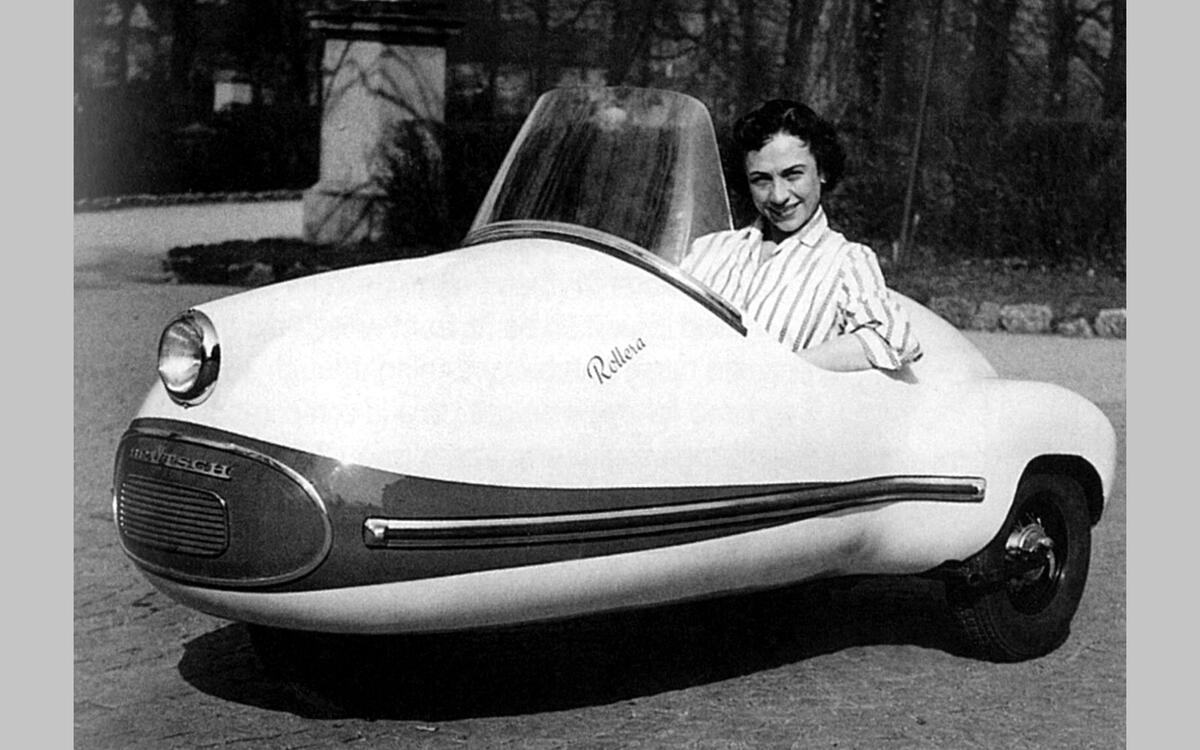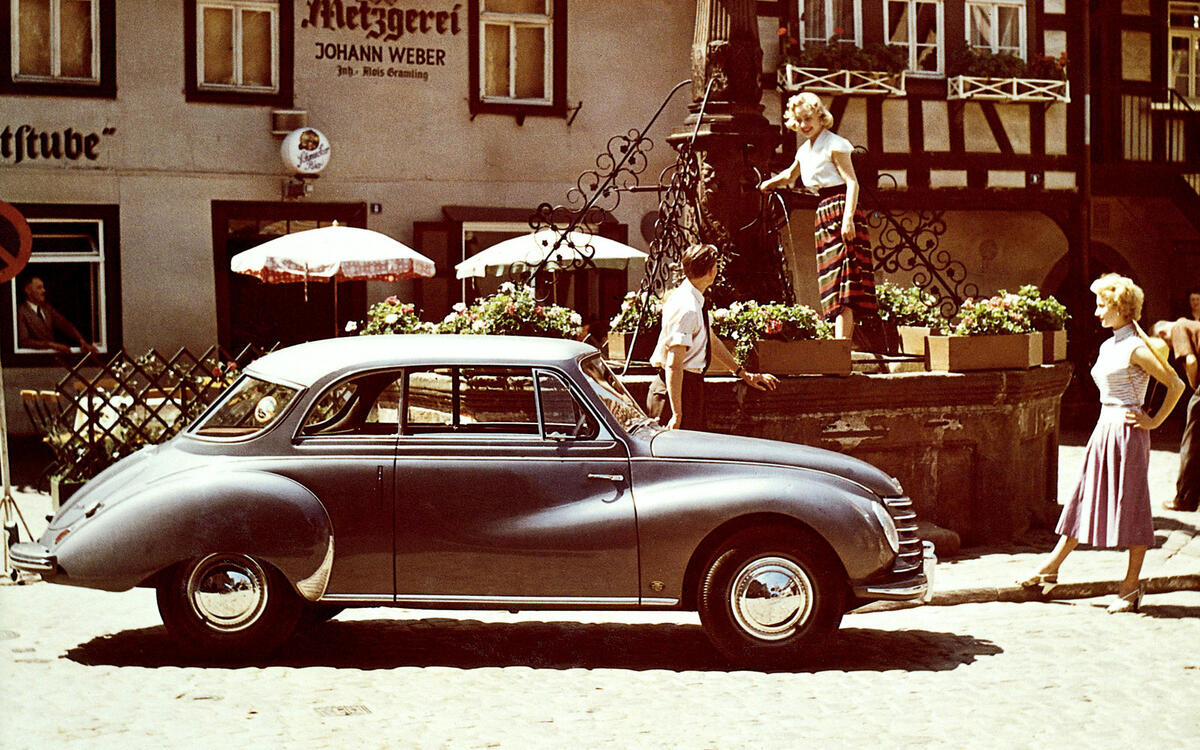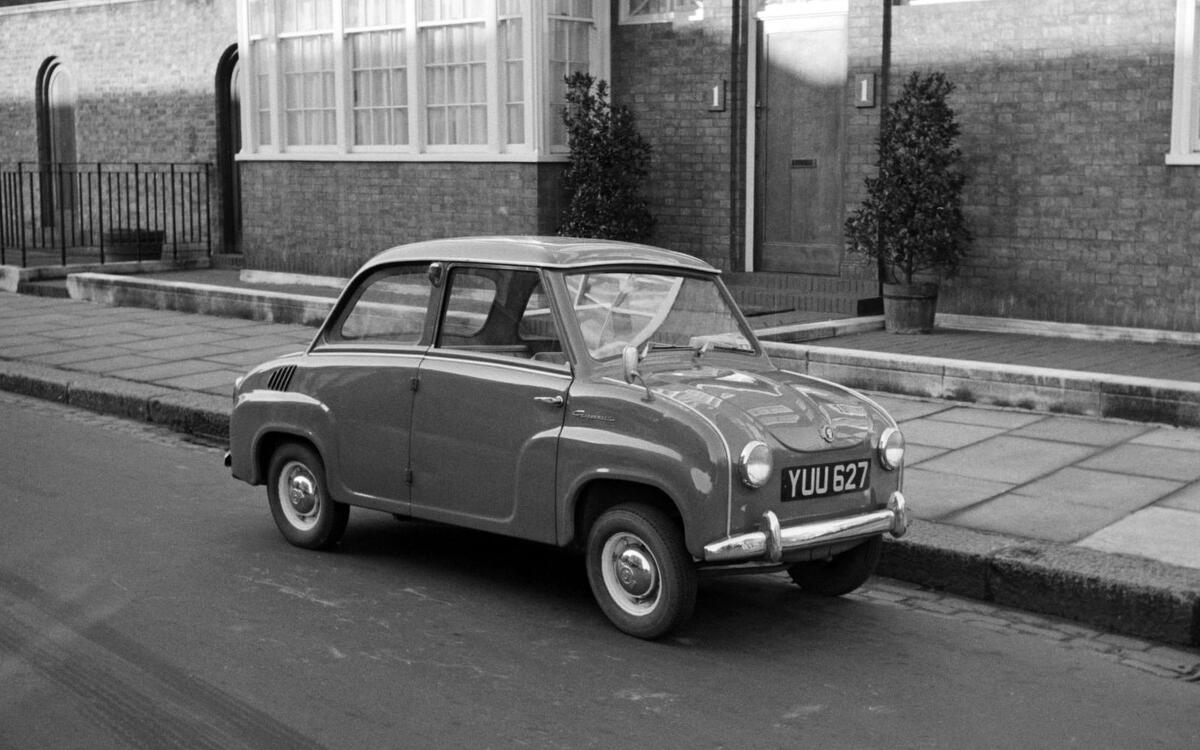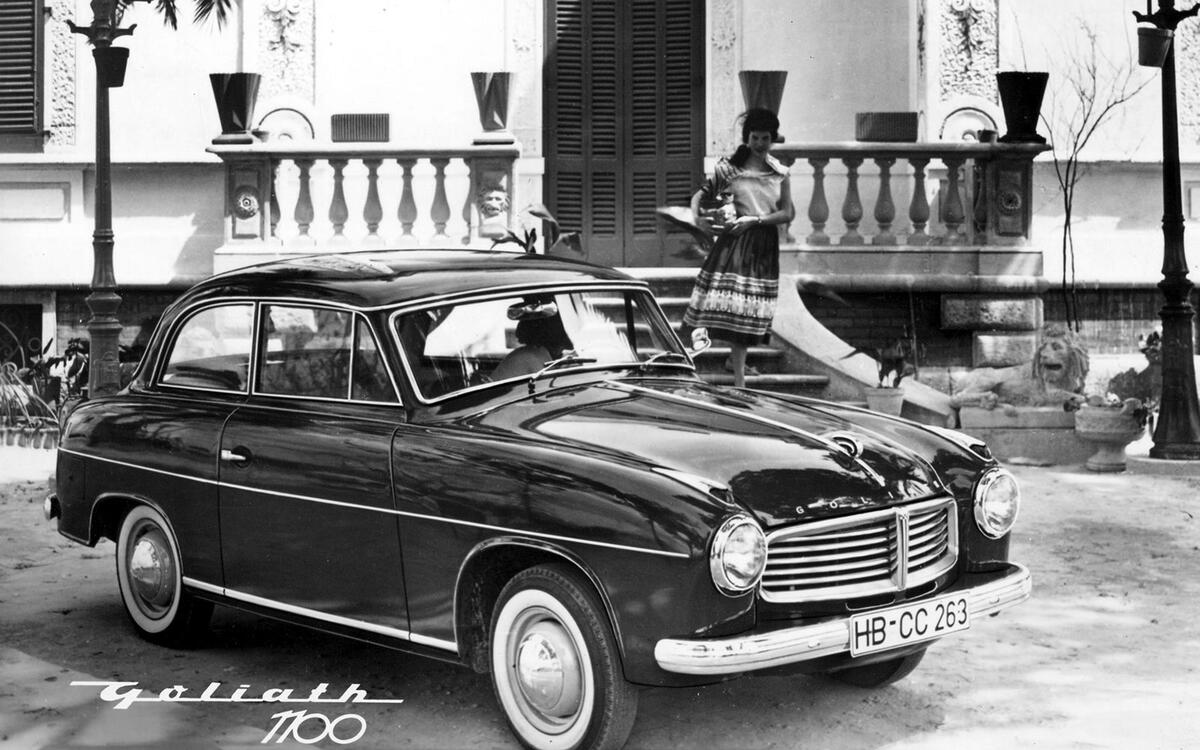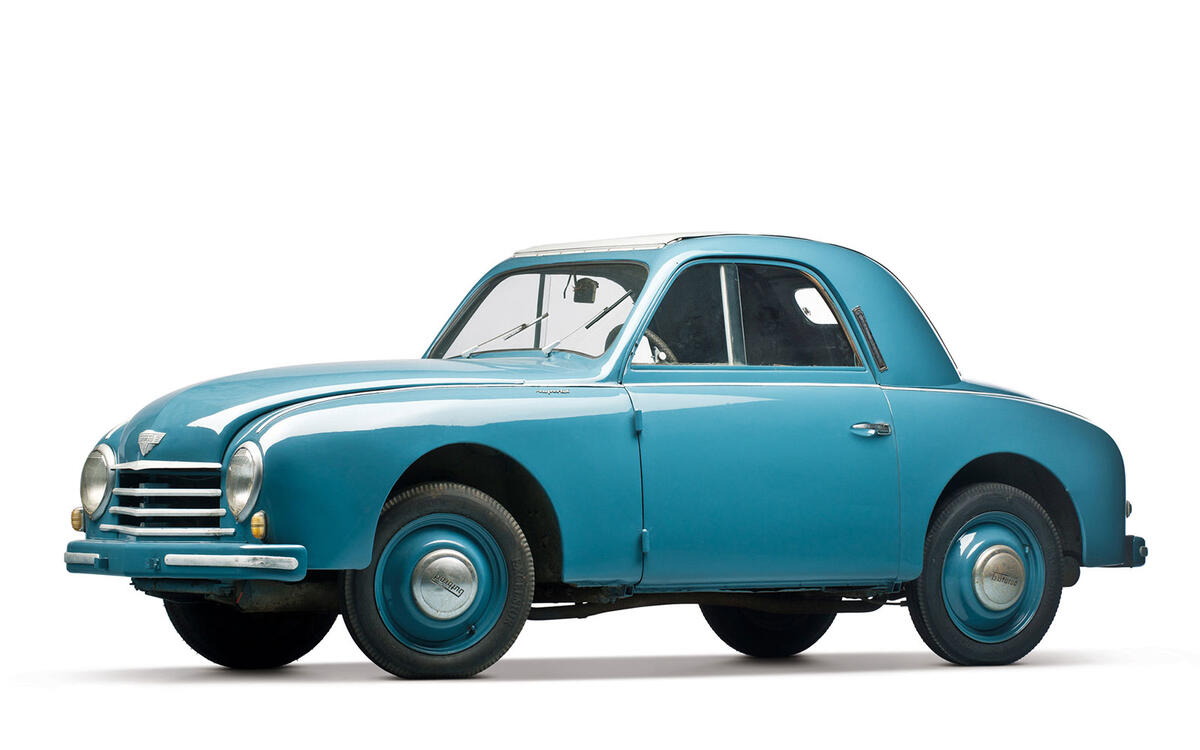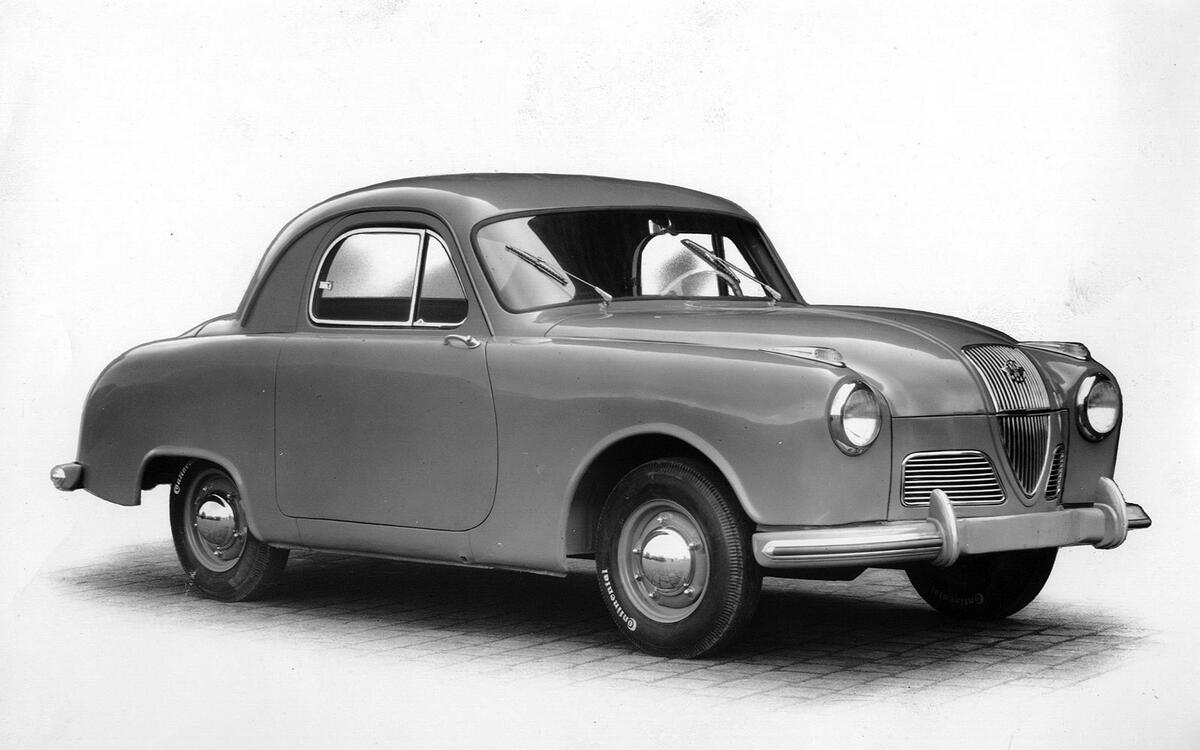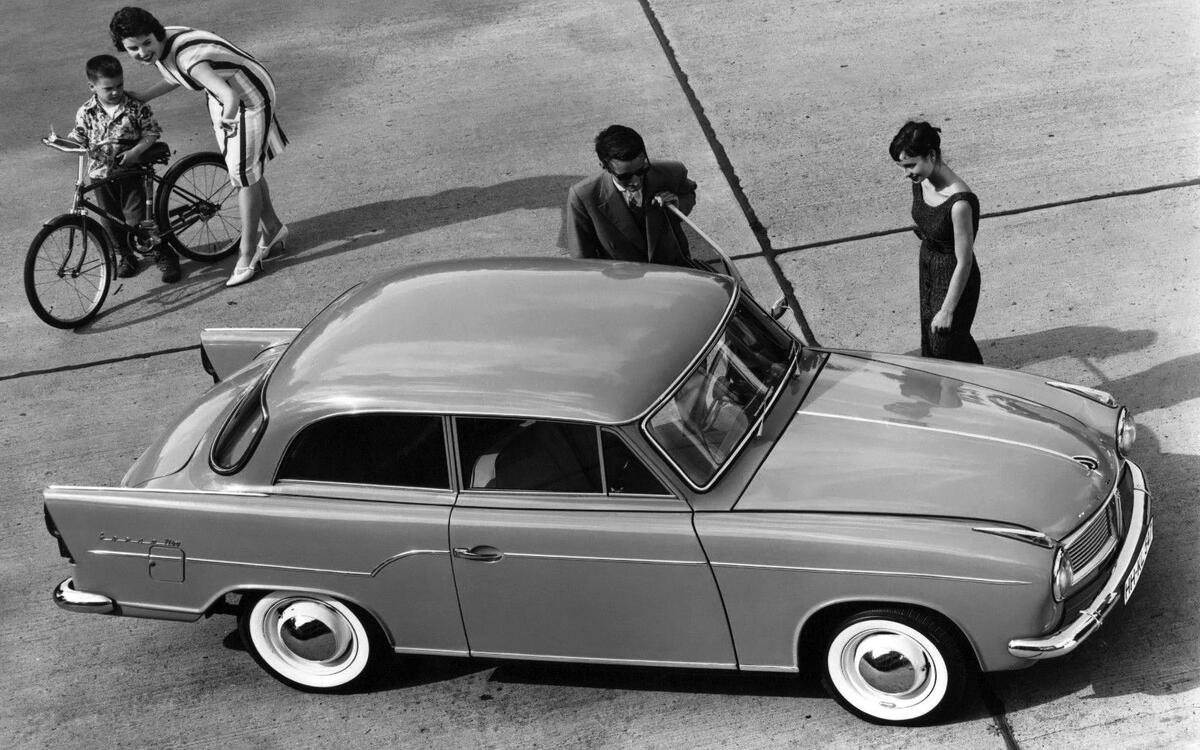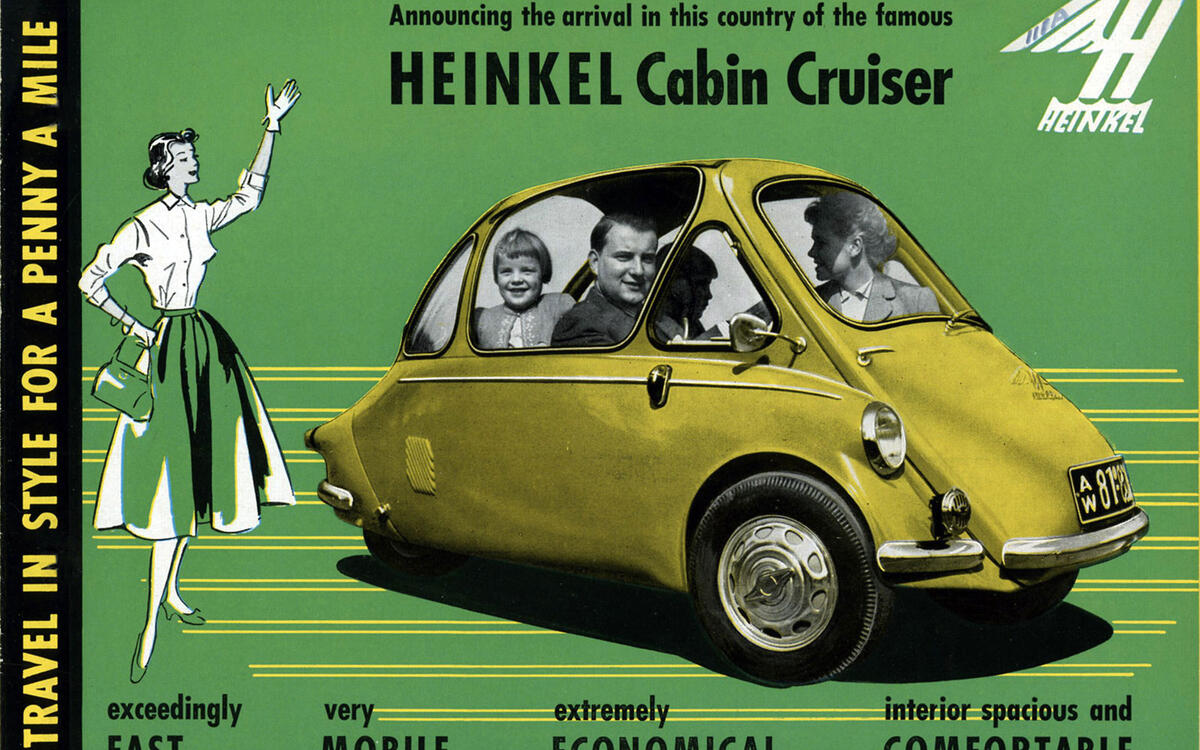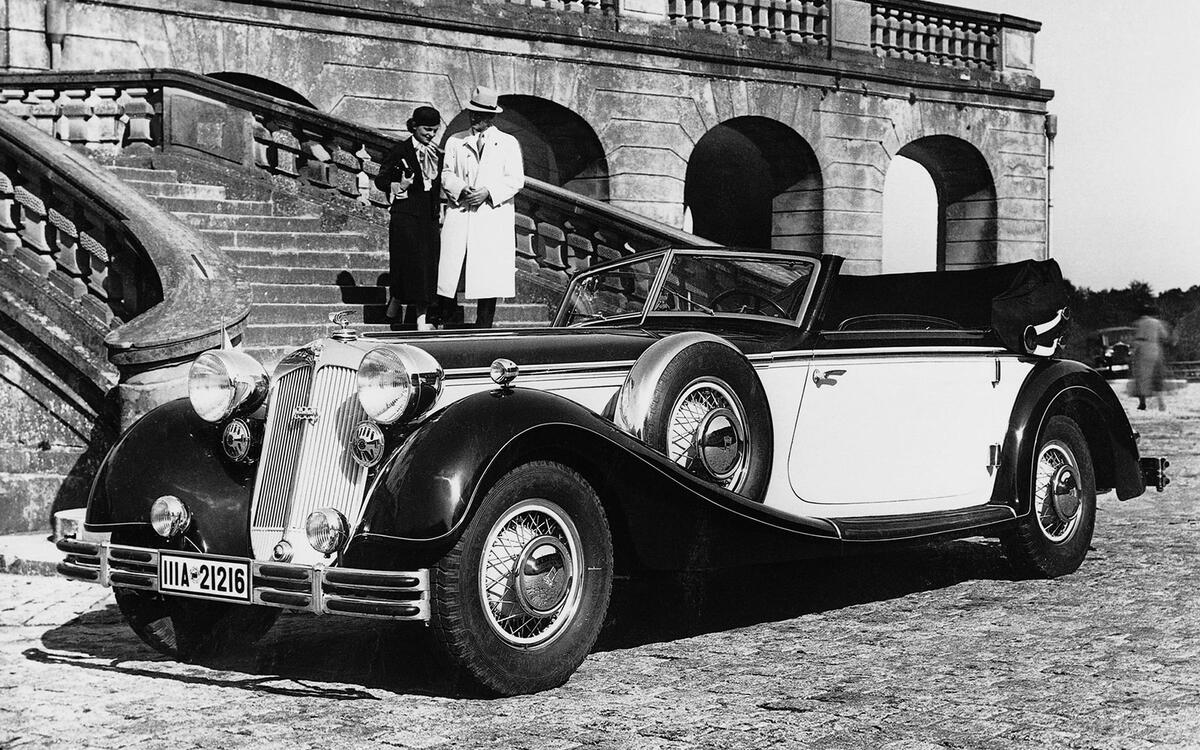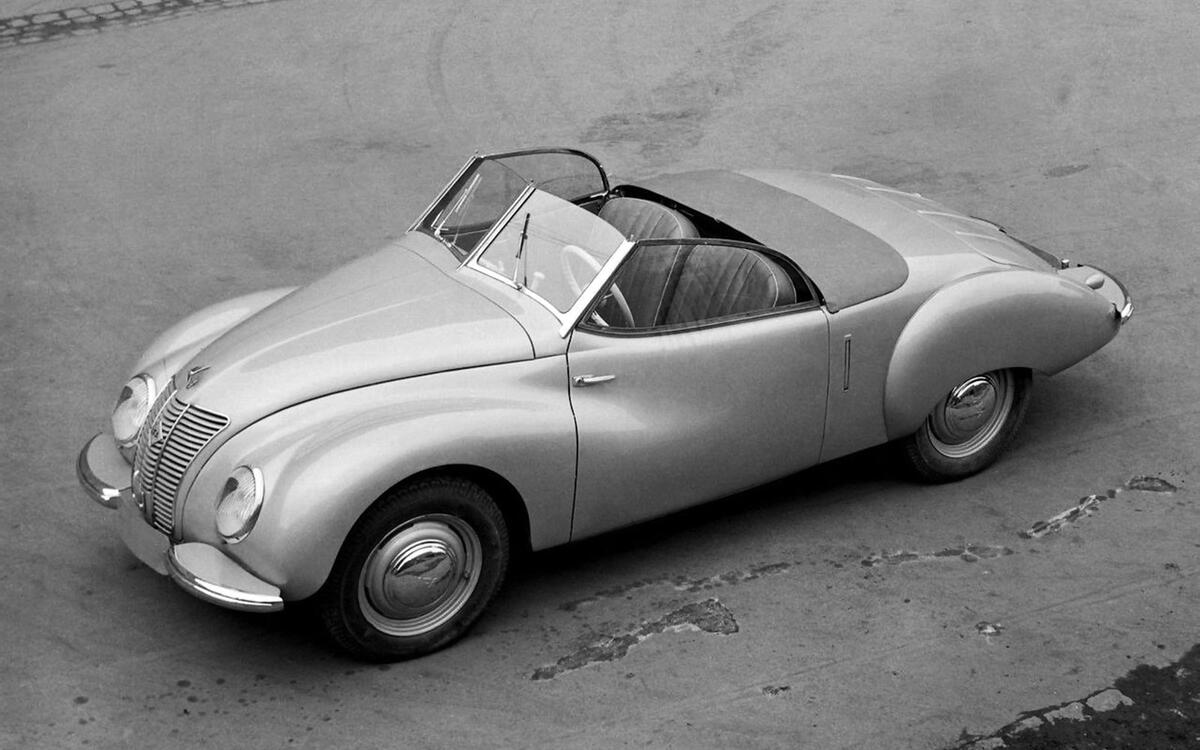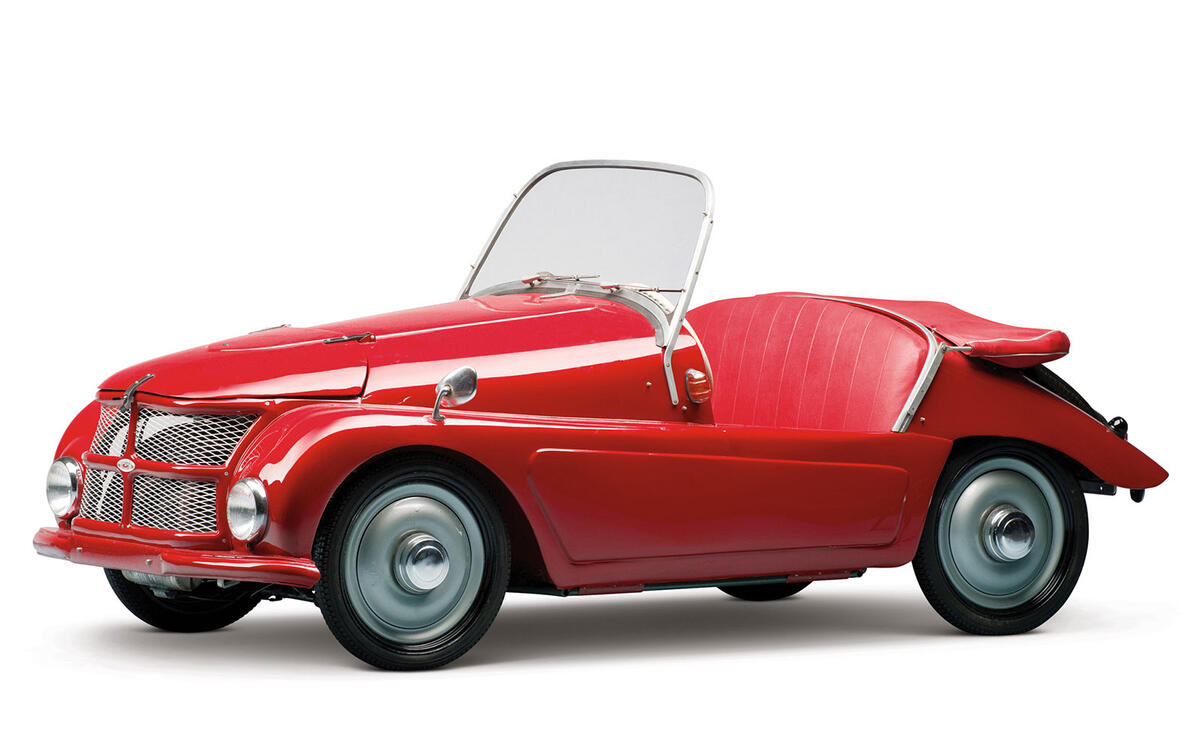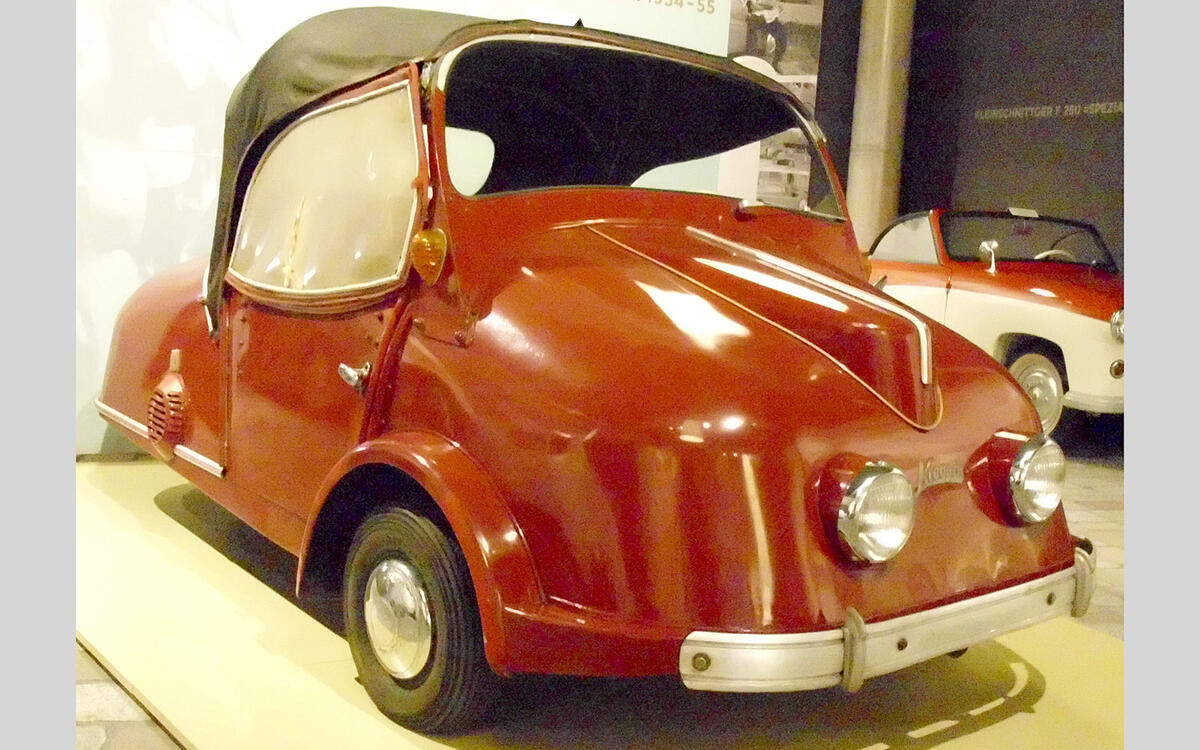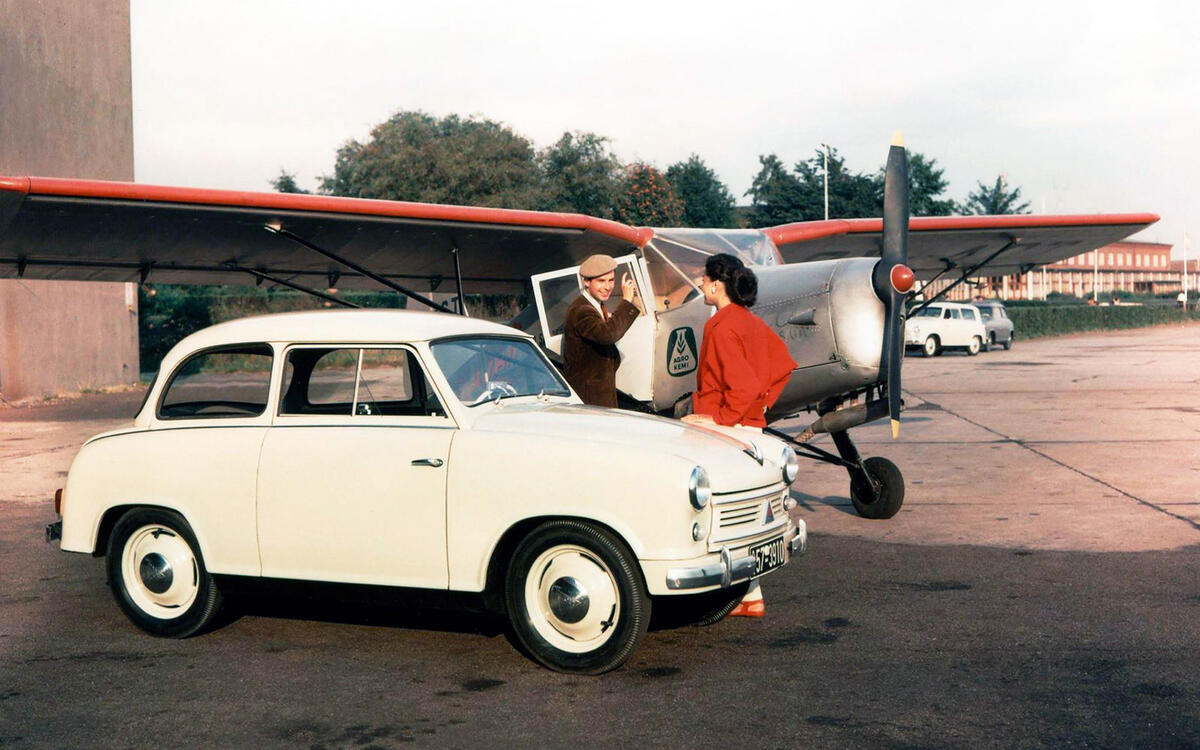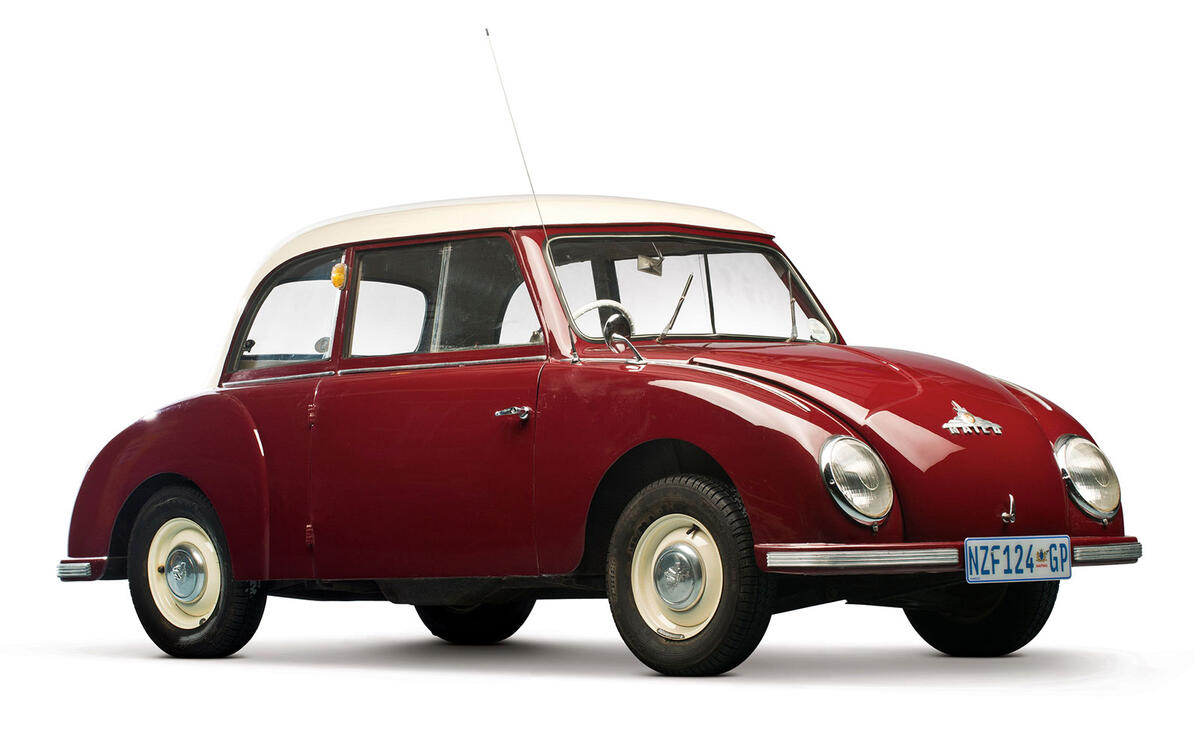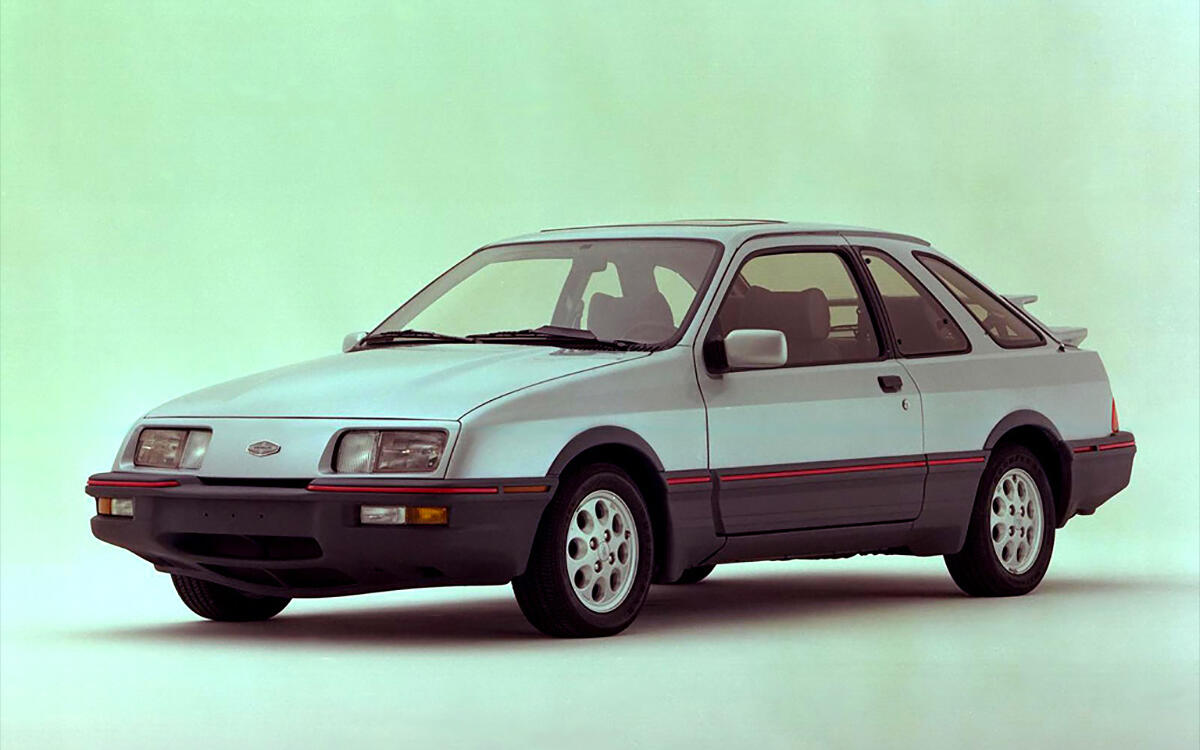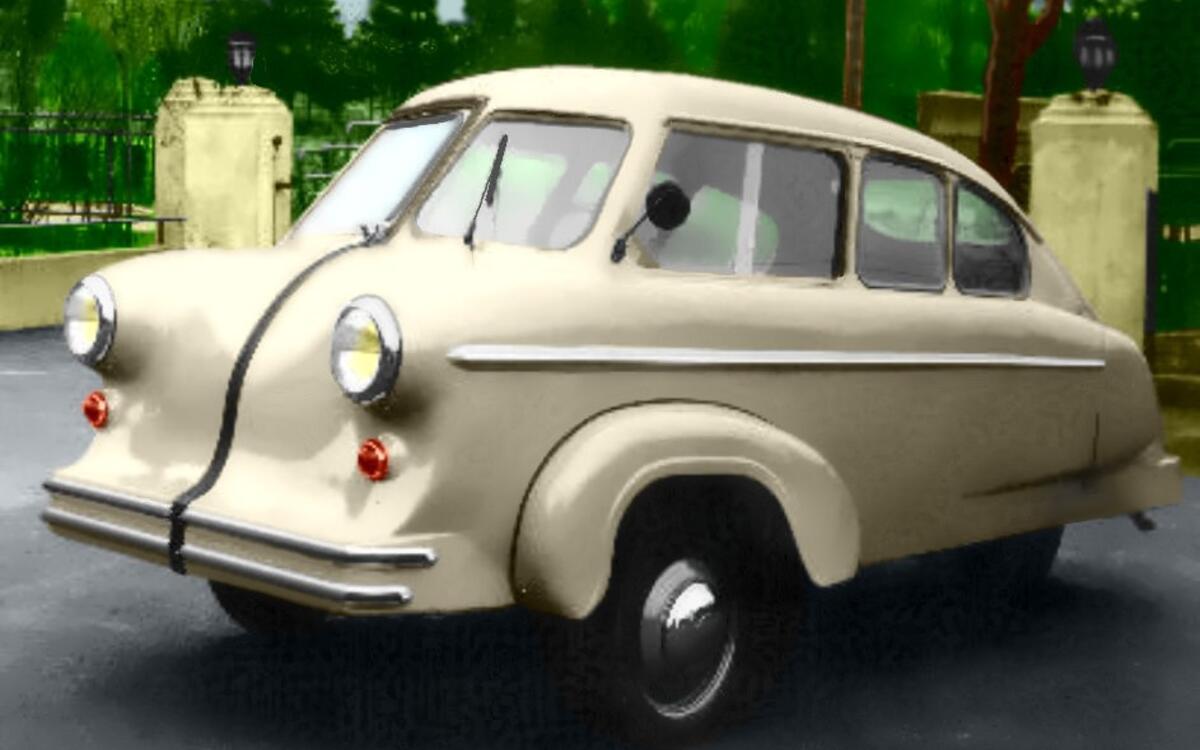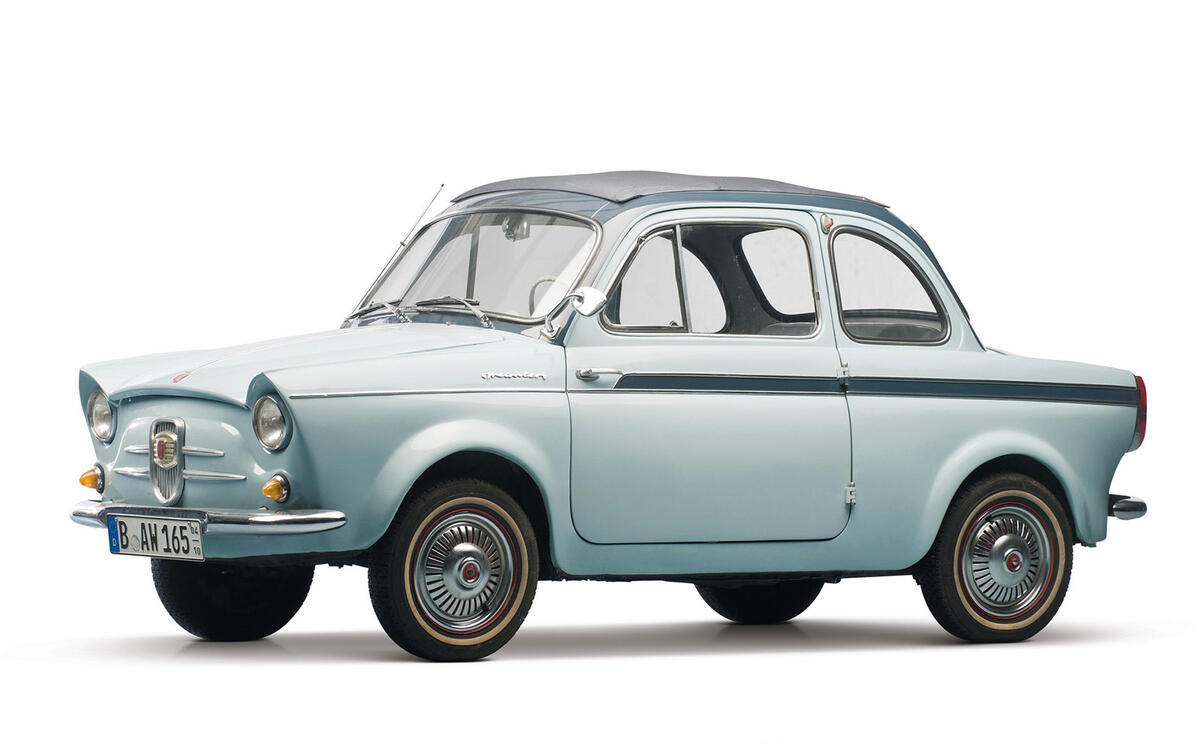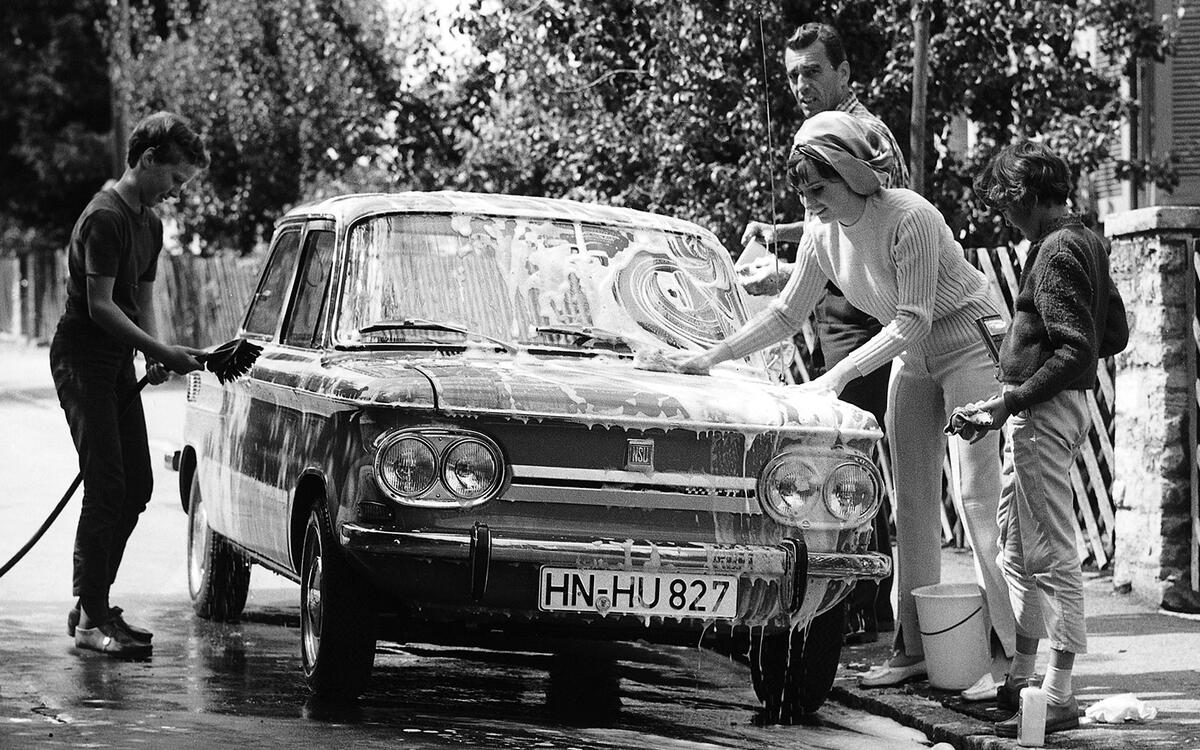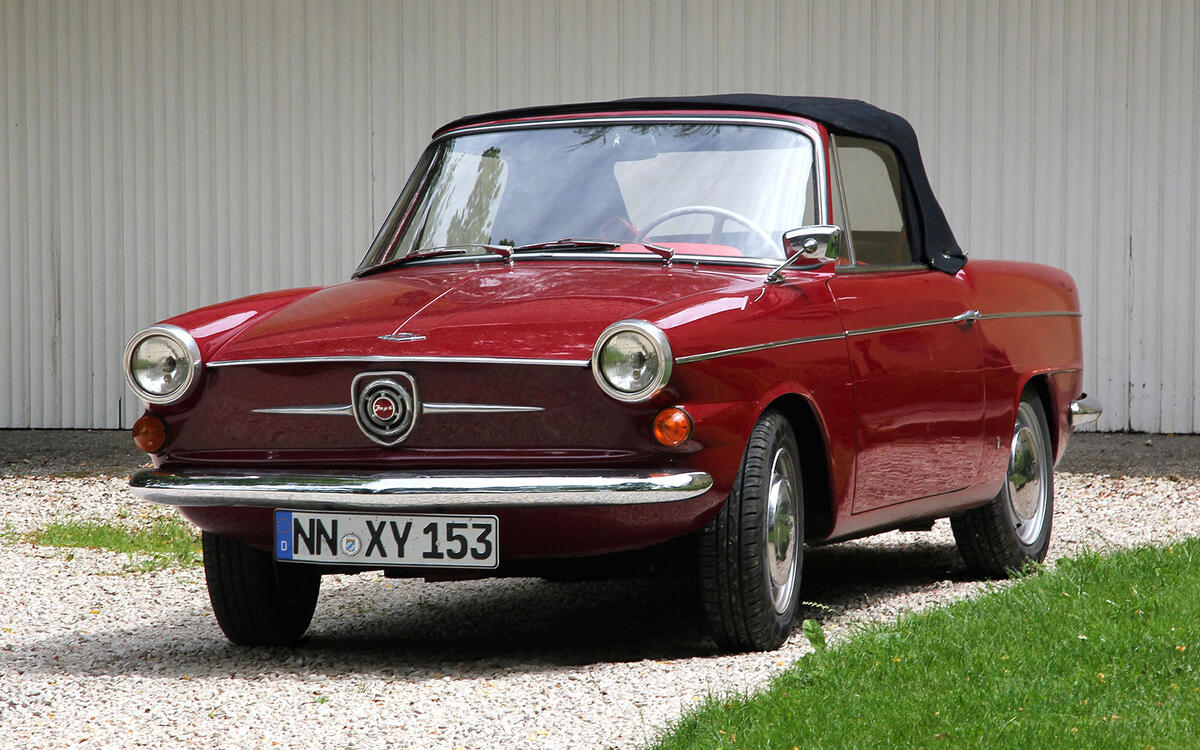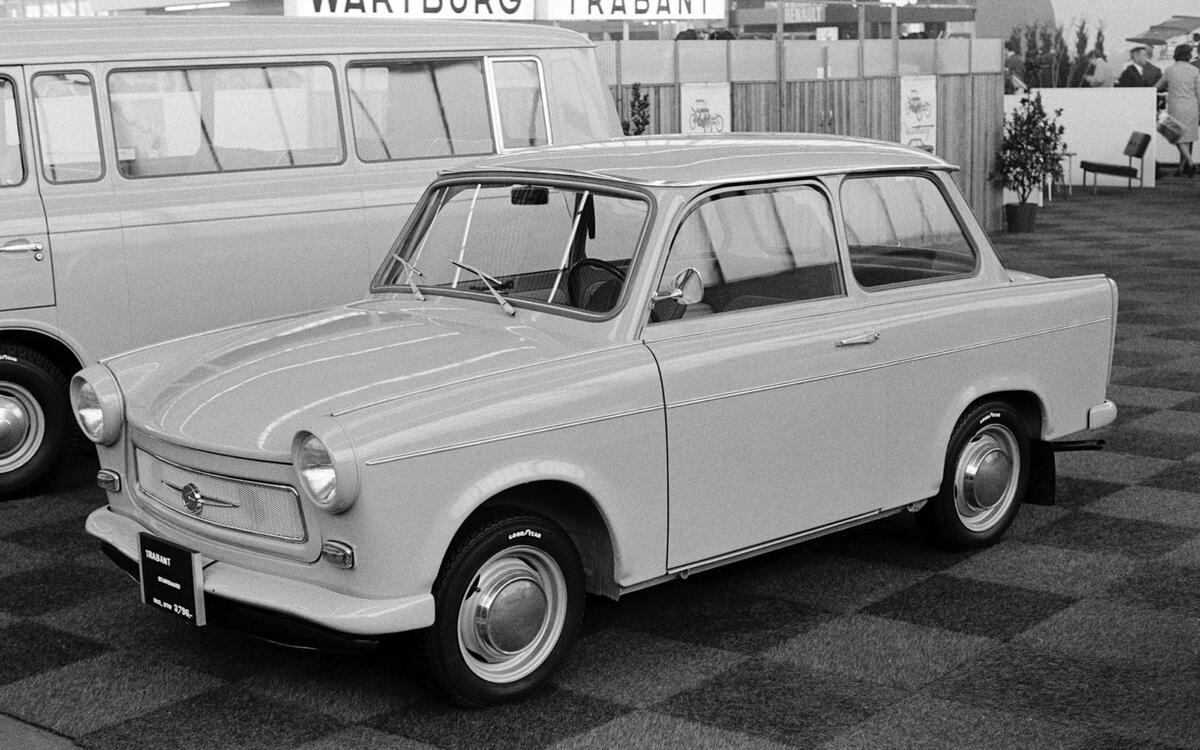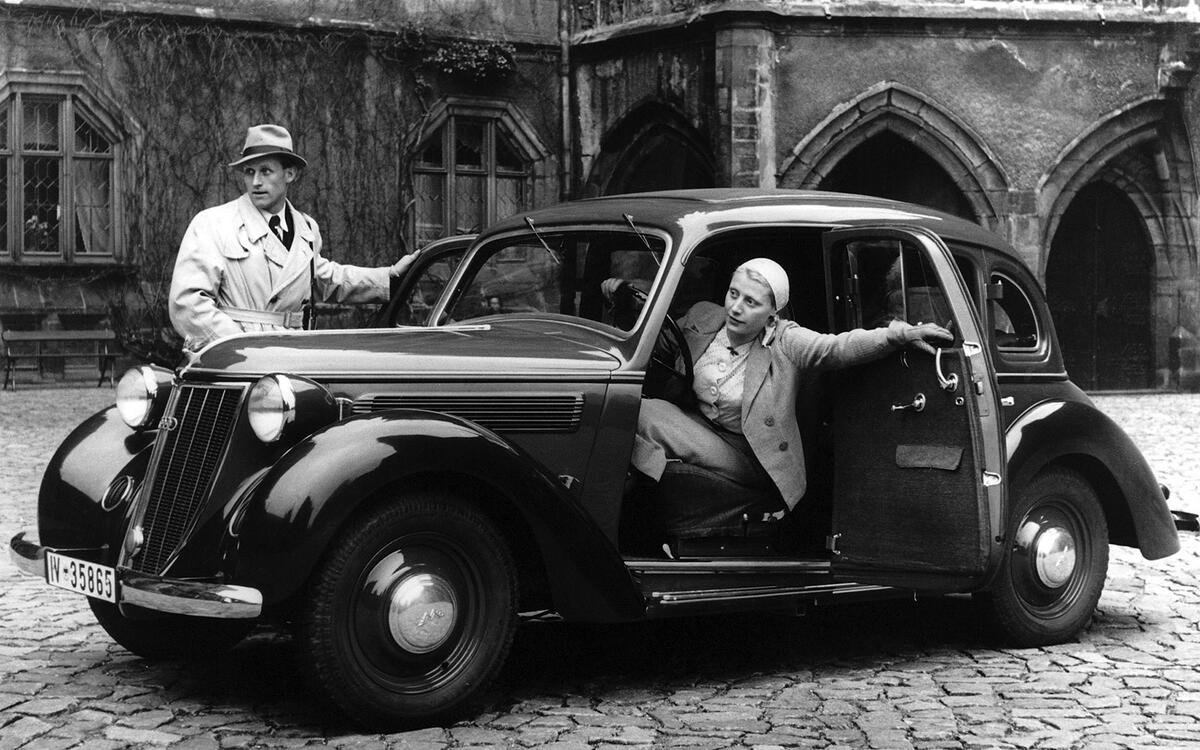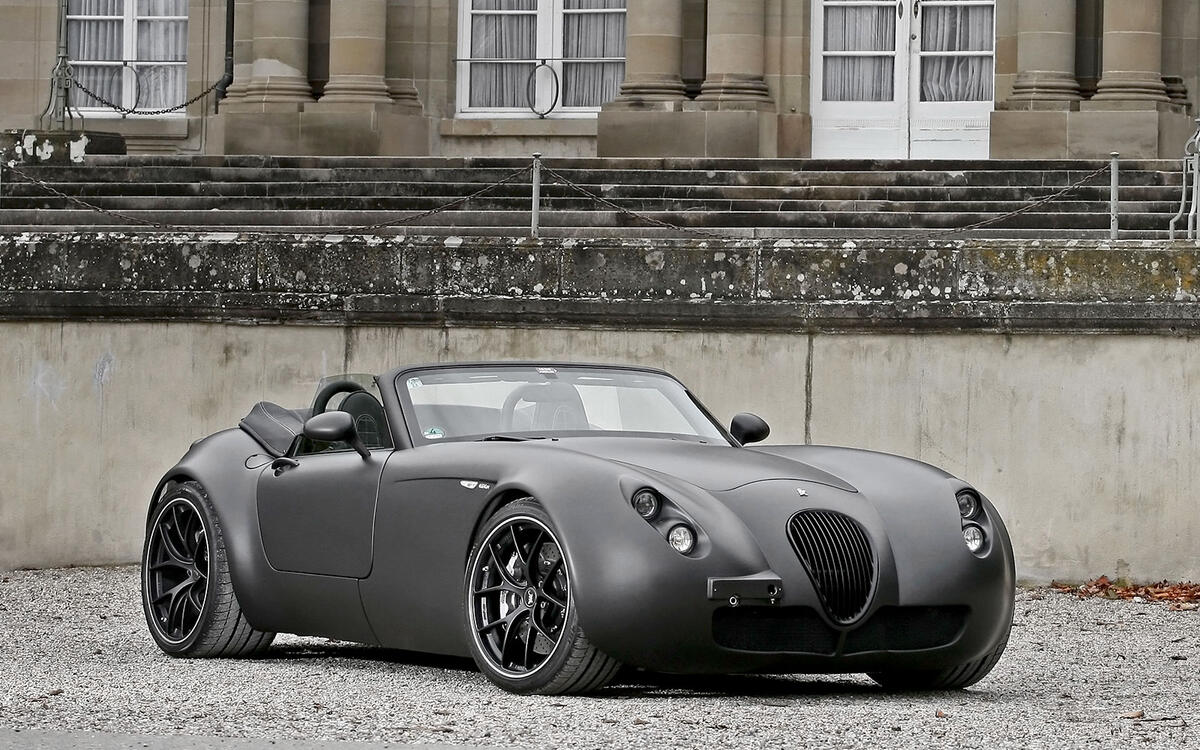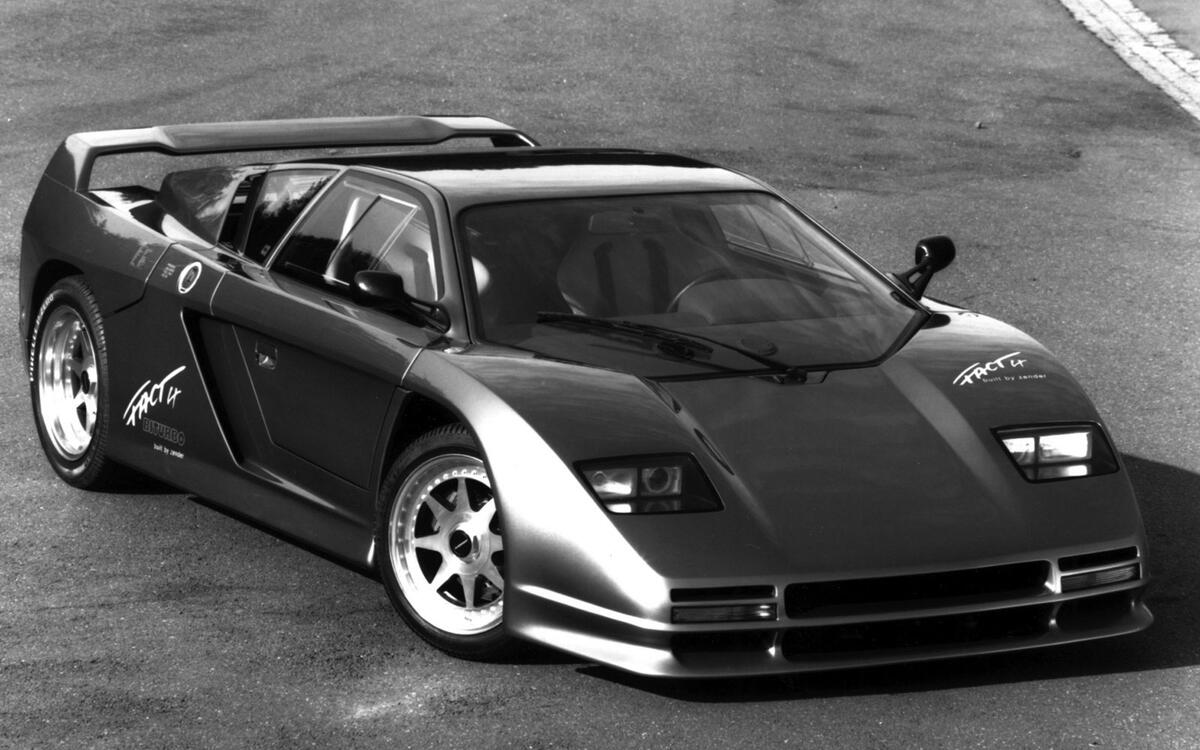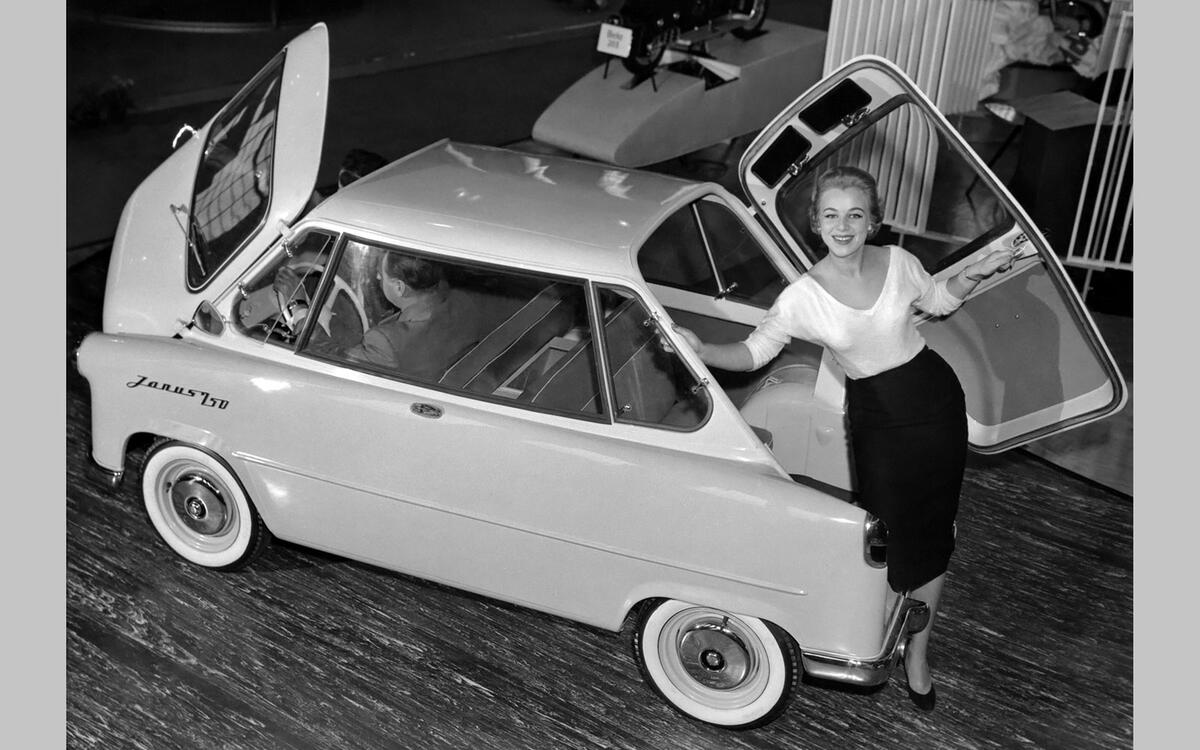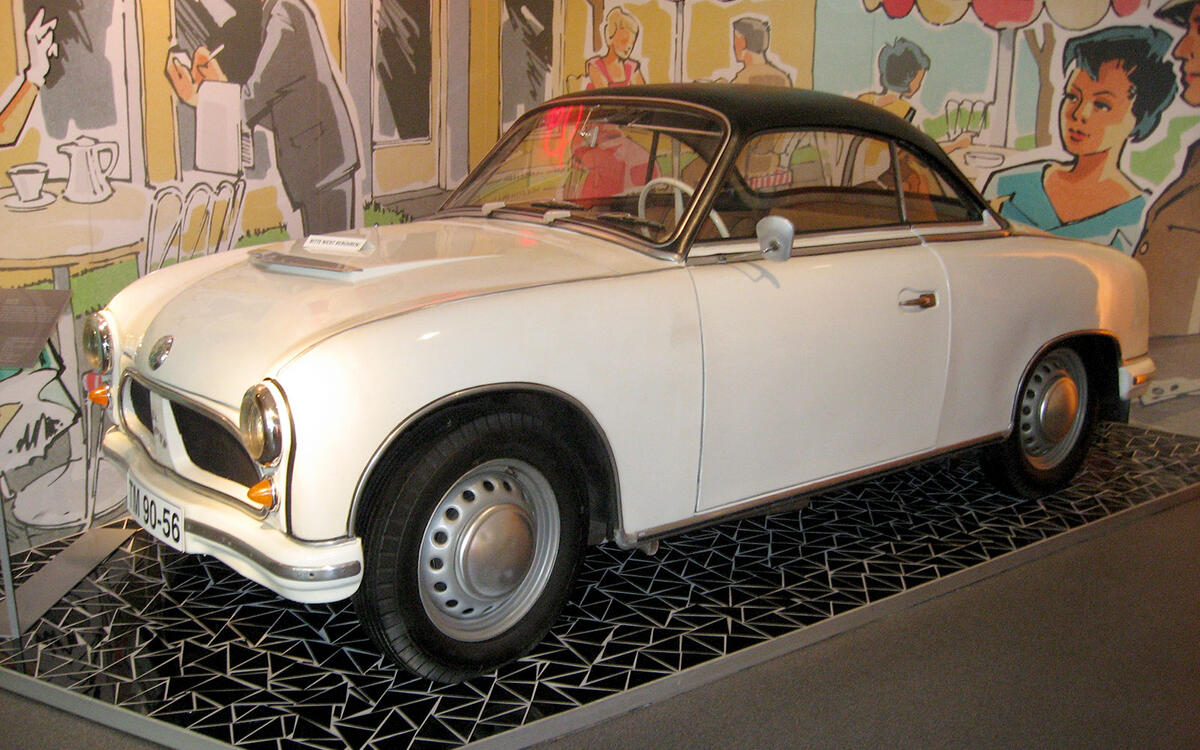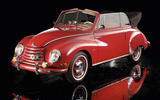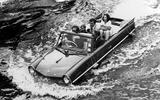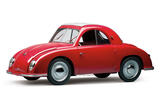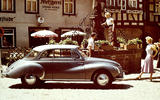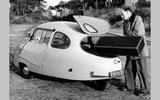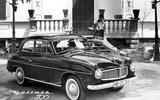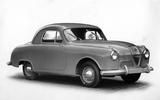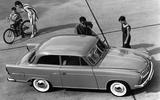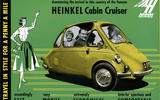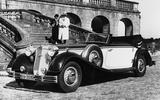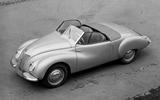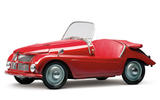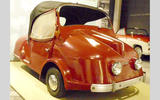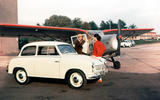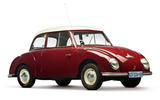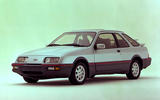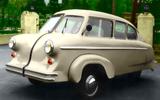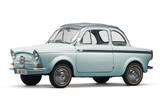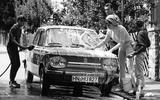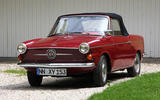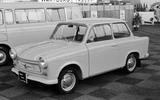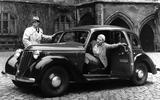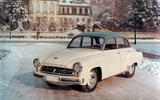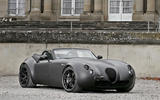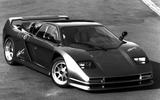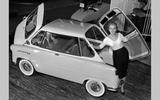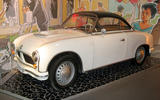 Slide of
Slide of
German car brands are some of the most aspirational in the world.
Synonymous with quality but no longer priced out of reach, German cars are now churned out in huge volumes and as a result have become far more accessible. But if you had to name a dozen German car brands dead or alive, you'd probably run out of steam before you were even half-way there.
However, over the years there's been a raft of companies that have tried and failed to make a success of car manufacturing, many before the war and quite a few in the post-war period. These are just some of those that didn't make it:
 Slide of
Slide of
Amphicar (1961-1968)
Over the years there have been quite a few attempts to make a commercially successful amphibious car. Most have gone nowhere but not this one; almost 4000 examples of Hans Trippel's Triumph Herald-powered Amphicar 770 were sold. Most found buyers in the US, but a handful were sold in European markets including the UK.
PICTURE: Amphicar 770
 Slide of
Slide of
Borgward (1924-1961)
If you wanted a premium German car in the 1950s, Borgward was the place to go, with its stylish saloons, coupés and estates, most notably the Isabella shown here. Carl Borgward started making cars under his own name in 1924, but in the pre-war years he also set up or acquired the Hansa, Lloyd and Goliath brands.
This would prove his undoing as he operated the companies separately in the post-war era, which led to a high cost base – so he could never compete with brands such as Opel and Volkswagen. The company closed down in 1961 and Carl Borgward died two years later, but in 2008 his grandson Christian revived the brand to make SUVs, backed with Chinese money.
PICTURE: Borgward Isabella
 Slide of
Slide of
Brutsch (1952-1958)
Egon Brutsch made some of the smallest, most basic mircocars ever created – to the point where he was taken to court in 1956 because his designs were deemed to be dangerous. Most of Brutsch's cars featured a single-cylinder engine, no doors and just three wheels; none of his designs were very successful. During a six-year production span Brutsch produced no fewer than 11 models but it's reckoned the total production figure for all of these was a mere 81 units.
PICTURE: Brutsch Rollera
 Slide of
Slide of
Champion (1948-1954)
Champion launched its 250 in 1948 to provide low-cost transport, with power provided by a supercharged single-cylinder 200cc rear-mounted two-stroke engine. In 1951 the 400 joined the 250, with a 398cc two-cylinder engine, roll-back cloth roof and improved suspension.
Inspired by the VW Beetle, it was the Wolfsburg-built car that would prove the Champion's undoing as it was much more usable and cost much the same. Champion collapsed in 1952 but was revived twice before the whole concern was sold to motorcycle manufacturer Maico in 1955.
PICTURE: Champion 400
 Slide of
Slide of
DKW (1928-1966)
Part of the Auto Union that was formed in 1932 (alongside Audi, Horch and Wanderer), in the 1920s DKW (Das Kleiner Wunder, or The Little Wonder) was the world's largest producer of motorcycles; by 1928 it had built its first two-stroke car. Up to the outbreak of war DKW focused on selling affordable small cars; in the post-war era the company was the first to offer a front-wheel drive model in Europe.
But in 1958 Mercedes-Benz took over Auto Union before selling it to Volkswagen in 1964, and by 1966 the DKW brand had been mothballed with all future cars wearing Audi badges instead.
PICTURE: DKW 3=6
 Slide of
Slide of
EMW (1945-1956)
BMW's main plant before WW2 was in Eisenach in East Germany. After the war it was nationalised by the Soviets but continued to produce BMWs – until BMW took legal action in 1952. The result was a change of brand to EMW (Eisenach Motorenwerk), but the models stayed much the same until the company was wound up in 1956, with the factory then being turned over to the production of Wartburgs.
PICTURE: EMW 340
 Slide of
Slide of
Fuldamobil (1950-1960)
Elektromaschinebau was based in Fulda and the company's only model was the Fuldamobil. A three-wheeled coupé with a rear-mounted single-cylinder engine, the first Fuldamobils featured a wooden frame with alloy panels; later models got an all-steel body, then in 1957 came a change to a glassfibre structure.
In time a cabriolet was offered along with a four-wheeler (with the rear wheels very close together); taking cars built under licence into account, the last Fuldamobils were made in 1969 although the original company shut up shop in 1960.
PICTURE: Fuldamobil 200
 Slide of
Slide of
Glas (1955-1969)
Glas started out in 1895 as a producer of agricultural machinery. By 1951 it had built its first motorcycle (the Goggo) then in 1955 came its first car, the Goggomobil saloon. Power came from two-cylinder two-stroke engines displacing 247cc, 296cc or 395cc; later came a coupé and a van with the same powerplants. A move upmarket led to 1.3- and 1.7-litre coupés being introduced along with a 2.6-litre V8-powered GT in 1966 – but it was the company's last hurrah as Glas was absorbed into BMW in 1966.
PICTURE: Glas Goggomobil saloon
 Slide of
Slide of
Goliath (1928-1961)
The industrious Carl Borgward teamed up with Wilhelm Tecklenborg in 1928 to launch Goliath, initially to make three-wheeled light trucks. The three-wheeled single-cylinder Pionier passenger car followed in 1931, then in 1950 came the GP700, a neatly styled coupé, saloon, cabriolet and estate, powered by a 688cc two-cylinder two-stroke engine. From 1957 Goliath adopted four-stroke engines but by 1958 the brand was dead.
PICTURE: Goliath 1100
 Slide of
Slide of
Gutbrod (1926-1954)
As with so many of the companies here, Gutbrod began by making motorbikes (in 1926). Set up by Wilhelm Gutbrod, his son Walter took over the business after his father's death in 1948, by which point the company had moved into manufacturing small two-stroke cars, most notably the Superior. Gutbrod closed down in 1954 but between 1975 and 1990 an identically named company set up shop in Germany, to build small 4WD farm vehicles.
PICTURE: Gutbrod Superior
 Slide of
Slide of
Hanomag (1925-1952)
In 1835 Georg Egestorff set up a company with the catchy name of 'Eisen-Giesserey und Maschinenfabrik Georg Egestorff', to build farm machinery and subsequently steam locomotives. A change of name to the even more unwieldy 'Hannoversche Maschinenbau Actien-Gesellschaft vorm. Georg Egestorff, Linden vor Hannover' in 1871, led to a contraction of this name being used: Hanomag.
Steam road vehicles followed in 1905 and 20 years later came a petrol-powered economy car, the 2/10, with a 500cc single-cylinder engine. Up to the outbreak of war in 1939 Hanomag introduced further models but after WW2 plans for an all-new car came to nothing and the company focused on making trucks and tractors before it was broken up and sold on to other companies.
PICTURE: 1953 still-born Hanomag prototype
 Slide of
Slide of
Hansa (1906-1961)
That Carl Borgward gets everywhere, and here he is again. Hansa started to make trucks and economy cars in 1905, but then merged with Lloyd in 1914 to become Hansa-Lloyd-Werke AG. Absorbed into the Borgward empire in 1929, by this point Hansa had moved upmarket with its cars but in 1937 the company resorted to making only trucks; Hansa became a model of car made by Borgward, which was made right up to the company's demise in 1961.
PICTURE: Hansa 1100
 Slide of
Slide of
Heinkel (1955-1958)
Between 1922 and 1945 Heinkel was best known for its military aircraft, but when the war ended in 1945 the company suddenly found itself with empty order books and anyway was banned from making them. The answer was to move into motorcycle manufacture in 1952, with a microcar following in 1955. Similar in concept to the BMW Isetta, there was a single front door, a single rear wheel (from 1957 there were two rear wheels very close together) and a 175cc single-cylinder four-stroke engine. Heinkel made its last car in 1958 but the Kabine lived on as the Trojan 200, made in England up to 1965.
PICTURE: Heinkel Kabine/Cabin Cruiser
 Slide of
Slide of
Horch (1899-1939)
August Horch was the manager of Karl Benz's factory between 1896 and 1899, when he decided to set up his own car manufacturing business. His first car was built in 1901 but things were tough and by 1909 Horch was squeezed out of his own company by its board of directors. He retaliated by setting up a new company called Audi, which would join the Auto Union alongside Horch in 1932.
Horch would continue to produce cars under its own name until 1939, but after the war the company's Zwickau factory was in East Germany so it was turned over to truck production under the Soviets. As part of the Auto Union group, the dormant Horch brand is now owned by Volkswagen.
PICTURE: Horch 853 A Sport Cabriolet
 Slide of
Slide of
IFA (1948-1956)
Industrieverband Fahrzeugbau (Industrial Association for Vehicle Construction), was a union of companies based in East Germany, which made everything from bicycles and motorbikes to cars, vans and trucks.
Based on pre-war DKW designs, IFA's cars were outdated but in the communist GDR any cars were hard to get, which is why there was still a ready market for the the F8 and F9 (shown here) which remained in production until 1956. That was when the IFA brand was killed off, replaced by Wartburg and Zwickau.
PICTURE: IFA F9
 Slide of
Slide of
Kleinschnittger (1950-1957)
Paul Kleinschnittger set up shop in 1950 to offer a 125cc single-cylinder front-wheel drive microcar with no roof and seating for two. The two-stroke powerplant peaked at just 5.4bhp and gave a top speed of 43mph, but the aluminium-bodied F250 could achieve 90mpg, which was more important to buyers.
Around 3000 F250s were made between 1950 and 1957; a 250cc coupé prototype was made in 1954 but it never went into production and three years later Kleinschnittger was no more.
PICTURE: Kleinschnittger F250
 Slide of
Slide of
Kroboth (1954-1955)
Gustav Kroboth had two stints at building cars. Between 1931 and 1932 his company made about 150 two-stroke two-seaters but it's the post-war stint that he's best known for – not that Kroboth is what you could call a high-profile brand.
That's largely because between 1954 and 1955 he made just 55 or so three-wheelers, each powered by a 197cc single-cylinder engine – there were a few four-wheelers made too, with a 174cc engine, but by the mid-1950s Kroboth was gone for good.
PICTURE: Kroboth Allwetter-Roller
 Slide of
Slide of
Lloyd (1908-1963)
Norddeutsche Automobil und Motoren GmbH (North German Automobile and Engines) was set up in 1908 by the Norddeutscher Lloyd shipping company. Many of the company's products were badged as Lloyds but when the company was absorbed into the Borgward empire in 1929 it seemingly disappeared for good.
But Carl Borgward revived the brand in 1950, to build economy cars with small engines (250-596cc). In 1957 came the Arabella, a 900cc saloon, but when Borgward went into receivership in 1961 Lloyd's days were numbered and it closed down for good in 1963.
PICTURE: Lloyd 600
 Slide of
Slide of
Maico (1955-1958)
When Champion went bust for the last time in 1955, its assets were available at a knock-down price, so motorcycle manufacturer Maico waded in to continue production of the two-seater 400; a four-seater version of this car arrived soon after. Next came a 452cc version of the 400, now called the Maico 500, but the car couldn't compete with more mainstream rivals.
A last-ditch attempt to continue with car production led to 10 500 Sport Cabriolet prototypes being made but the money ran out. Maico managed to stave off bankruptcy and stuck with motorcycle production until the brand's demise in 1986.
PICTURE: Maico 500
 Slide of
Slide of
Merkur (1985-1989)
For decades US car makers had it all their own way in their home market, but things started to change in the 1980s, with European brands starting to gain traction. Ford's response was to introduce the Merkur brand; a range of German-built cars re-engineered to comply with federal laws. At first there was just the XR4Ti, sold in Europe as the Sierra XR4i; later came the Scorpio (shown here).
But buyers weren't interested in these federalised European cars and by 1989 the Merkur brand had been killed off.
PICTURE: Merkur XR4Ti
 Slide of
Slide of
Meyra (1948-1956)
Wilhelm Meyer started to make three-wheeled invalid carriages in 1948, but in 1953 he moved up a gear with the 200, a bubble car-style model with a single wheel at the back powered by a 197cc single-cylinder engine. Bizarrely, the 200 featured just a single door on its front, much like the Isetta, but this door was just half the width of the car, ensuring no fatties could get in.
Production ran to 530 units by the time it all went belly up in 1956.
PICTURE: Meyra 200
 Slide of
Slide of
Neckar (1959-1967)
As you'll read shortly, Neckar was an interim marque dreamed up by the suits at Fiat, which had taken over NSU's factory at Heilbronn. When NSU resumed car making in 1959, NSU-Fiat had to come up with a new brand and Neckar was chosen, after the river that ran past the factory building. But when Fiat decided to put its own name on cars built from 1967, the Neckar brand was killed off.
PICTURE: Neckar Weinsberg 500
 Slide of
Slide of
NSU (1905-1977)
Christian Schmidt set up Mechanische Werkstätte zur Herstellung von Strickmaschinen in 1873 to make knitting machines; bicycles followed in 1886, motorbikes in 1901 and finally cars in 1905. In 1929 a struggling NSU sold its factory to Fiat but the former continued to make motorbikes before restarting car manufacture in 1957 with the Prinz.
Seven years later NSU introduced the world's first Wankel-engined car, the Spider, and although not all of NSU's cars were rotary powered, the company is probably best known for the Ro80 that was the 1967 Car of the Year – and also the model which bankrupted NSU because of its shocking fragility.
Volkswagen bought NSU in 1969 from which point the company was known as Audi NSU Auto Union AG until it was closed for good in 1977. Pictured is the NSU TT model; it’s because of ownership of this nameplate that Audi was able to give the same name to its iconic TT model that launched in 1998.
 Slide of
Slide of
NSU-Fiat (1929-1967)
Right, brace yourself for this one because it's seriously confusing… On the verge of bankruptcy in 1929, NSU sold its Heilbronn factory to Fiat, which henceforth made NSU-Fiats there – even though the factory was owned 50/50 by Fiat and the Dresdner Bank, NSU having no stake. The first cars were called NSU-Fiat Standards but were actually just Fiat's regular models such as the Balilla, 1100 and 1500 along with the 500 and 600. NSU, which had continued to make motorcycles, then started to produce cars once again in a separate factory; to avoid confusion NSU-Fiat was rebranded Neckar Automobilwerk but its products still sometimes carried NSU-Fiat badges.
From 1967 the Neckar name was dropped with all cars being branded Fiat – until 1973 when things changed once more with the company being known as Deutsche Fiat AG. Got that?
PICTURE: NSU-Fiat Jagst 770 Riviera
 Slide of
Slide of
Trabant (1957-1991)
Of all the brands here, probably the most recognisable is the Trabant, the car that came to symbolise the demise of the Berlin Wall. The official family car of the GDR, the Trabant's proper name was the VEB Sachsenring, the first product of which was the P50 or 500, launched in 1957. Within a year the 600 had arrived and although this was facelifted in 1963 to become the 601, the Trabant barely changed until its demise in 1991, when its captive market was able to buy VW Golfs instead.
However, while virtually all of the 3.7 million Trabants featured a small two-stroke engine, for the last year of production a 1.1-litre VW-sourced four-stroke unit was fitted.
PICTURE: Trabant 601
 Slide of
Slide of
Wanderer (1911-1942)
Wanderer was launched in 1911 by motorcycle manufacturer Winklhofer & Jaenicke. Wanderer was initially W&J's export brand but it was soon sold in the domestic market too, focusing on well-made mid-range four-cylinder cars. A six-cylinder model was launched in 1926, six years before Wanderer was incorporated into the Auto Union group in 1932.
The Wanderer brand survived into the War with the factory turned over to making munitions, but when the production facility was destroyed in 1945 it spelled the end of the Wanderer marque.
PICTURE: Wanderer W24
 Slide of
Slide of
Wartburg (1956-1990)
Another East German gem, Wartburg's official name was VEB Automobilwerk Eisenach. First used between 1898 and 1904, the brand was revived in 1955 for the successor to the IFA F9. While the F9's 900cc three-cylinder two-stroke engine was carried over, for the Wartburg there was an all-new bodyshell that came as a convertible, saloon or estate.
Known as the 311 (pictured), 312 or 313 depending on year and bodystyle, this rather pretty initial model gave way to the 353 in 1966 – a model which came to the UK in right-hand drive form and which was the reason why Wartburg has such a terrible reputation in the west. It was massively outclassed by western rivals but the Wartburg brand still managed to survive in its domestic market until the Berlin Wall came down.
PICTURE: Wartburg 311
 Slide of
Slide of
Wiesmann (1993-2014)
Wiesmann isn't quite a defunct manufacturer as it's just been brought back from the dead, having closed down in 2014. The company, founded by two brothers, made its first car in 1993. With its retro styling and modern BMW mechanicals the MF30 was an enticing prospect, if a rather expensive one. Power came from a BMW 3.0-litre straight-six engine with the MF4 of 2003 ushering in a new V8-powered era. The MF 5 of 2009 (pictured) featured a V10 engine, which like the V8 came from BMW.
The company is today being in the process of being revived, and we recently spotted its new MF 6 camouflaged on the back of a trailer in Germany.
 Slide of
Slide of
Zender (1969 on)
Zender set up shop in the late 1960s to offer styling kits and graphics for owners to personalise their cars. When the market for bodykits exploded in the 1980s Zender was at the forefront of wide-arch styling and huge wheels, but it also built several show cars to showcase what it could do (including the Fact 4 shown here) – it worked with manufacturers to develop official styling accessories. While Zender still exists (as the Zender Group), it hasn't built a show car since 2001; nowadays its focus has reverted to styling kits.
PICTURE: Zender Fact 4
 Slide of
Slide of
Zundapp (1957-1958)
Although Zundapp started motorcycle production as early as 1917, it would be another 40 years before it offered its first car; the Janus, after the Roman god who faced both ways. Originally developed as the Dornier Delta, this bubble car was symmetrical with the two pairs of passengers sitting back to back in the centre of the car above the engine.
A high price and weird handling meant demand was limited although almost 7000 Januses were built before Zundapp gave up and sold the project on to Bosch. Zundapp continued to build motorbikes though, until going bust in 1984.
PICTURE: Zundapp Janus
 Slide of
Slide of
Zwickau (1956-1959)
Picking up where IFA left off was the Zwickau, short for VEB AWZ (Volkseigenes Betrieb Automobilwerke Zwickau, or Zwickau Automobile Works Company Owned by the People). The joy of abbreviations… The first German car to feature glassfibre construction – and only the world's second, after the Chevrolet Corvette - there were saloon, coupé and estate P70s available, with around 36,000 made before the Trabant P50 took over where the Zwickau P70 left off.
PICTURE: Zwickau P70
If you enjoyed this story, sign up to Autocar’s newsletter for all the best car news, reviews and opinion direct to your inbox. Click here to subscribe.
In the automotive arena, German brands are some of the most successful. But not all Teutonic car companies went on to change the world…
Advertisement

